BANKS IN JAPAN
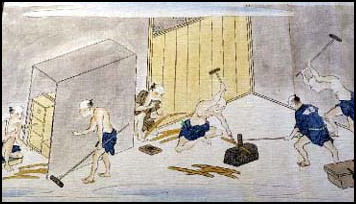
Minting gold coins
in the 19th century Japanese banks play a much bigger role in the Japanese economy than their counterparts do in the West. Banks are among the biggest holders of Japanese stock. Japanese companies have traditionally financed themselves through bank loans rather than money from investors. The financial system is reliant on big banks and long term lending relationships.
Banks, brokerage houses and insurance companies are all notoriously inefficient and in need of restructuring. Banks and brokerages are way overstaffed. The idea of the government insuring bank depositors is a new idea that is slowly taking hold in Japan.
Japanese banks offer account in American dollars and Chinese yuan. In recent years yuan denomination accounts have begun drawing more attention.
Banks traditionally haven’t acted totally like banks. Lending hasn’t been based on economics or concepts of risk management but rather have been based on promoting a broader national good. Weak companies have been carried by stronger ones and the economy has been kept rolling with a cheap supply of yen.
In May 2009, the head of the BJP urged banks to reduced their stocks and holdings in Japanese companies and said their failure to do so could undermine the domestic economy, citing the risks and hardships caused when stocks fall in value.
Consumer Loans. See Economic History and Customs, Economics and Daily Life
Websites and Resources
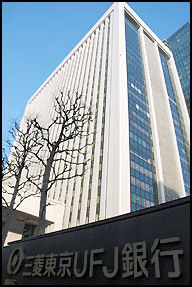
Good Websites and Sources: Good Photos at Japan-Photo Archive japan-photo.de ; Financial Services Industry fsa.go.jp/en ; Statistical Handbook of Japan Finance Chapter stat.go.jp/english/data/handbook ; 2010 Edition stat.go.jp/english/data/nenkan ; News stat.go.jp Japan Post japanpost.jp/english ; Japan Post Bank jp-bank.japanpost.jp
Japan’s Three MegaBanks 1) Mizuho Financial Group mizuho-fg.co.jp ; 2) Mitsubishi UFJ Financial Group mufg.jp/english ; 3) Sumitomo Mitsui Financial Group smfg.co.jp/english ; Mitsui mitsui.com ; Sumitomo sumitomocorp.co.jp
Financial Scandals Daiwa Bank Scandal nytimes.com ; Wikipedia article on the Sumitomo Copper Scandal Wikipedia ; How Copper Became a Cropper slate.com ; Time Magazine on Takafumi Horie and the Livedoor Scandal time.com ; Japan Times article on Takafumi Horie japantimes.co.jp ;Yoshiaki Murakami News yoshiaki-murakami-news
Links in this Website: JAPANESE STOCK MARKETS Factsanddetails.com/Japan ; JAPANESE COMPANIES Factsanddetails.com/Japan ; BANKS AND FINANCIAL SCANDALS IN JAPAN Factsanddetails.com/Japan ; RETAILING IN JAPAN Factsanddetails.com/Japan ; TRADE AND OVERSEAS BUSINESS IN JAPAN Factsanddetails.com/Japan ; BUSINESS CUSTOMS AND PRACTICES IN JAPAN Factsanddetails.com/Japan ; MACROECONOMICS IN JAPAN Factsanddetails.com/Japan ; JAPAN INC. AND REFORMS Factsanddetails.com/Japan ; ECONOMIC HISTORY OF JAPAN AFTER THE 1970s Factsanddetails.com/Japan ; ECONOMIC REFORMS AND RECOVERY IN THE 2000s Factsanddetails.com/Japan ; JAPAN AND THE GLOBAL ECONOMIC CRISIS IN 2008 AND 2009 Factsanddetails.com/Japan ;
Good Websites and Sources on Business: Statistical Handbook of Japan Finance Chapter stat.go.jp/english/data/handbook ; 2010 Edition stat.go.jp/english/data/nenkan ; News stat.go.jp Financial Services Industry fsa.go.jp/en Business News: Far Eastern Economic Review www.feer.com ; Nikkei.com nikkei.co.jp ; Japan Corporate News japancorp.net ; Wall Street Journal Asia asia.wsj.com ; Japan Investor japaninvestor.com ; Japan Economy Watch japanjapan.blogspot.com ; Japan Center for Economic Research jcer.or.jp/eng ; Japan Inc. Economic and Business News japaninc.com
Marketing Japan Marketing News /japanmarketingnews.com ; Plunkett Research plunkettresearch.com ; Research and Markets researchandmarkets.com ; Asaho Shimbun Market Trends asahi.com/english/market ; Business Organizations Japanese Business Organizations mizuho-sc.com ;Keidanren (Most Powerful Business Group in Japan) keidanren.or.jp ; Keizai Koho Center, Keidanren’s Research Arm kkc.or.jp/english Entrepreneur Association of Japan ea-tokyo.com ; Bizfinder Directory of Trading Companies ebiz.co.jp/bizfinder ; Business Customs and Practices: Culture- at-Work culture-at-work.com ; Executive Planet executiveplanet.com ;Tips on Doing Business in Japan cyborlink.com ; More Tips on Doing Business in Japan euro-technology.com ; Kwintessential kwintessential.co.uk
Large Japanese Banks
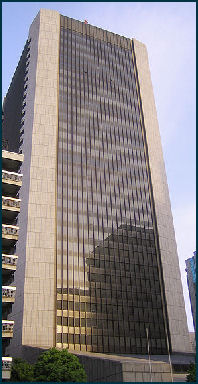
Mizuho headquarters Japan’s five major financial groups, including its three megabanks — MUFG, SMFG, Mizuho, Resona and Sumitomo Mitsui Trust Holdings — made weak V-shaped recoveries after the Lehman Brother shock in 2008. By 2010 they had returned to about where they were in terms of profits before the shock. The driving force behind the recovery was higher stock prices. In fiscal 2010-2011 they made a profit of ¥1.76 trillion up 55 percent from the previous year. One of the main sources of profits was revenues made from selling government bonds, whose value has been pushed upwards as interest rates have fallen.
Japan top six banks made profits of ¥1.28 trillion in the April-September period in 2010, about 2.7 times more than a year earlier.
Japan’s banks have been reshaped by a series of mergers in recent years.
Top three banks in Japan as of March 2004: 1) Mizuho Holdings ($1.237 trillion in assets, 66,460 employees, 550 branches); 2) Mitsubishi Tokyo Financial Group ($957 billion in assets, 52,465 employees, 377 branches); 3) Sumitomo Mitsui Financial group ($918 billion in assets, 53,940 employees, 652 branches).
Sumitomo Mitsui Financial Group is the world’s 6th largest bank according to a 2008 Financial Times survey. It ranked 82nd on the Forbes magazine global corporate ranking list in 2008 and 65th in 2007.
SMFG made a net profit about ¥475.90 billion (about $6 billion) in fiscal 2010-2011, up 75 percent from the previous year. The company credited its profit growth to reduced credit costs and the sale of government bonds. Operating revenues grew 21.5 percent to ¥3.85 trillion.
SMFG debuted on the New York stock exchange in November 2010.
Resona made a net profit about ¥160.08 billion (about $1.9 billion) in fiscal 2010-2011, up 21 percent from the previous year. The company credited its profit growth to the improved economy and reduction of bad loans. Operating revenues were ¥859.9 billion.
In March 2011, the Resona banking group said it would return about $9.5 billion in public funds to the government fund in return for preferred shares as part of its effort to free itself from government control. The returned shares reduced the government’s stake in the bank from 36.8 percent to 27.2 percent in terms of voting rights, taking away the government’s veto power.
Mitsubishi UFJ
Mitsubishi UFJ Financial Group (MUFG) is Japan’s largest banking group and the world’s 6th largest bank according to a 2008 Financial Times survey. It ranked 35th on the Forbes magazine global corporate ranking list in 2008 and 40th in 2007.
Mitsubishi Tokyo Financial Group, Japan’s second largest bank at the time, and UFJ merged in October 2005. The launch was marked by computer glitches At the time the merger created the world’s largest bank in terms of assets ($1.7 trillion compared to Citigroup’s $1.3 trillion). Sumitomo Mitsui also tried to acquire UFJ through a hostile bid.
Mitsubishi UFJ Finanicial Group (known as both MUFG and MUFJ) is Japan’s largest bank by market value (2010).It returned to profit in the final quarter of fiscal 2009-2010 and made a net profit about ¥583 billion (about $7 billion) in fiscal 2010-2011, up 50 percent from the previous year and toping its target of ¥ 500 billion. The company credited its profit growth to reduced credit costs and a decline in business failures and bad loan write-offs.
MUFJ owned 22 percent of Morgan Stanley as April 2011. In the fall of 2008, immediately after the Lehman shock, MUFJ paid $9 billion for a tie-up with Morgan Stanley, which lost about $1.7 billion in fiscal 2010-2011 due to large losses from securities investments.
In the mid 1990s, Mitsubishi Tokyo Financial Group was the world's largest commercial bank according to the Guinness Book of Records. It had assets of $737 billion in April, 1996. The bank was the result of a merger of the Bank of Tokyo and the Mitsubishi Bank in the mid 1990s.
Mitsubishi UFJ Financial Group was the largest bank in Japan in terms of assets in 2005 with ¥190 trillion. It made a profit of ¥1.18 trillion in 2005, the biggest profit ever for a Japanese bank — and larger than Toyota’s — helping it pay back its bailout loans, nine months ahead of schedule.
UFJ made many bad loans in the 1990s and was accused of cooking the books and engaging in a variety of fraudulent activities. In October 2004, investigators with the Tokyo Prosecutors office raided their headquarters, acting on a criminal complain by Financial Services Agency (the Japanese equivalent of Securities and Exchange Commission.
MUSFG profits profits were down in 2008 because of the losses associated with weak markets and the U.S. subprime mortgage crisis.
Mizuho

Mizuho Financial Group is the world’s 15th largest bank according to a 2008 Financial Times survey. It ranked 71st on the Forbes magazine global corporate ranking list in 2008 and 59th in 2007. Mizuho has traditionally been known as a bank for individuals and small businesses.
Mizuho made a net profit about ¥413.23 billion (about $5 billion) in fiscal 2010-2011, up 72.6 percent from the previous year. The company credited its profit growth to cost savings as revenues fell by 3.5 percent from fiscal 2009-2010. Operating revenues were ¥1.29 trillion.
Mizuho Holdings was the world’s largest bank in terms of assets until it was displaced by Citigroup and the and a Swiss bank UFB. Formed in April 2001 from a merger of Dai-ichi Kangyo Bank, Fuji Bank and Industrial Bank of Japan, Mizuho does business with 70 percent of the companies listed on the Tokyo Stock Exchange and has assets of $1.3 trillion (2002). Mizuho means “ears of rice plant” in Japanese, a expression associated with youthful beauty
In 2002, foul ups in Mizuho’s computer systems led to rejections of cash cards, double-billing of 60,000 customers and delays of 2.5 million money transfer. The blunders were caused by problems linking the old computer systems of Dai-ichi Kangyo Bank, Fuji Bank and Industrial Bank of Japan and got so much bas press in Japan that thousands of girls named Mizuho complained they were mocked at school. Deposits dropped 9 percent after the problems and the company devoted much attention to winning back customers.
Japanese Postal Savings
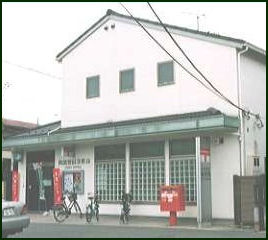
rural post office Nearly all Japanese have their savings in post office savings accounts. There are nearly $3.8 trillion invested in low interest postal savings account loans. Japan Post also hold ¥140 trillion of government bonds, making it the biggest owner of Japan’s national debt. If the Japanese postal system is regarded as a bank it would be the world's largest and some say the worst run.
Public corporations such as the postal services underwrote much of the economic activity in the 1990s but were very unprofitable. Large amounts of money from the system has been used by the government to fund pork barrel projects and finance bridges to nowhere.
The Japanese postal system also offered insurance policies. Unlike bank saving accounts and company insurance policies, post office savings accounts and insurance policies are protected by the government. The bank pays virtually no taxes and deposit-insurance premiums.
The postal system was regarded as a major obstacle to prosperity and economic growth because it sucked up household savings and wanted and used the money efficiently.
The world's largest lender is the Japanese-government-controlled House Loan corporation.
Banking Crisis in Japan in the 1990s
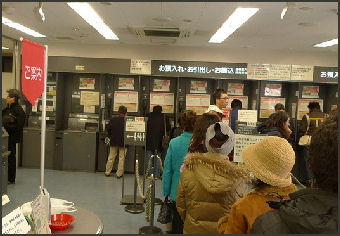
Inside a Japanese bank The collapse of the real estate values in the 1990s during the collpase of the bubble economy was devastating to Japanese banks. Banks have traditionally relied on property as collateral for loans. When real estate values plummet, the banks are reluctant to call in the loans because the value of the collateral is considerably less than it was before and the banks lose money.
Japanese banks were saddled with billions of dollars in debts and may have accumulated as much as $1 trillion in bad loans, or $5,000 for every Japanese. No one was sure how bad the situation really was. The Japanese government prevented the IMF from investigating the Japanese banking system and hid the full scale of the losses sustained by the banks to prevent the crisis from being worse than it was.
The bad loans were mostly held mostly by companies that accumulated large debts and couldn't pay the loans back. Instead of calling in the loans, the banks lent the companies more money to prop them up. This increased the debts further. To make money the banks entered risky ventures, which in many cases didn't pan out, causing the banks to loss even more money. For large companies the banks lived up to the saying: “If you owe a bank $10,000 you have problem. If you owe it $10 million you have a partner.” Companies that owed the banks lot of money sat on their bank’s boards and vetoed decisions.
The banks concealed bad loans in subsidiaries that were considered off-balance-sheet entities or listed derivative investments as profits when they were actually losses and put the loss five years in the future in the hope things would improve by then.
Some financial institutions went bankrupt. In 1993 there were 14,041 corporate bankruptcies. In the mid 1990s, several “jusen” (housing loan companies) straddled with debts of $84 billion (70 percent of their total outstanding loans) filed for protection. Many more companies should have gone bankrupt.
The post bubble financial crisis came to a head in late November 1997 with the collapse of Sanyo Securities and Yamaichi Securities — events comparable to the collapse of Bear Stearns and Lehman Brothers. The government responded by a de facto government guarantee of bank liabilities the following month.
Subprime Banking Crisis and Japan
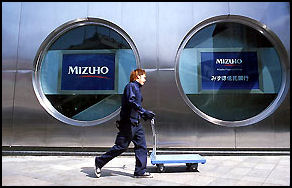
Japan’s six major bank groups lost almost ¥1 trillion as a result of the U.S. subprime mortgage crisis as of May 2008. .
The financial crisis in 2008 provided an opportunity for Japanese banks and investment houses to snap up assets and stakes in major Wall Street firms at fire-sale prices and improve their positions and stature abroad. Nomura Holding took over Lehman Brothers Asian assets, with a bid of $225 million, after Lehman Brothers collapsed.
In September 2008, in the midst of the global financial crisis following the collapse of Lehman Brothers, MUFG announced it was going up to 20 percent of troubled Morgan Stanley and become the Wall Street firm’s largest investor.
All Major Japanese Banks Record Large Massive Profits in Fiscal 2011
The nation's five major banking groups have released their consolidated balance reports for the 2011 fiscal year ending in March, with after-tax profits totaling 2.4 trillion yen, up 36.3 percent from the previous year. The figures show the first positive earnings in five years since the financial settlement for fiscal 2006, which produced an after-tax profits total of 2.82 trillion yen. [Source: Yu Toda, Yomiuri Shimbun, May 17, 2012]
“Yu Toda wrote in the Yomiuri Shimbun: “The largest factor that contributed to the good business showings among the five banking groups was the increased gains from transactions in government bonds. The prices of Japanese and U.S. government bonds were pushed up, while their yields fell, due to the escalation of the European sovereign debt crisis and global financial easing.The rise of stock prices around the end of March also pushed the banking groups' profits higher.
“Mitsubishi UFJ Financial Group Inc. posted a profit of about 290 billion yen by making the U.S. major finance firm Morgan Stanley an equity-method affiliate. An equity-method affiliate's profit can be reflected in the consolidated settlement. This pushed the after-tax profit of MUFG to 981.3 billion yen, the second highest amount since the group was launched in 2005. Due to their good business results, the nation's major banks will pay corporate tax next year. Sumitomo Mitsui Banking Corp., which had deficits due to previous massive losses, will pay tax for the 2013 fiscal year for the first time in 15 years.
“The profits from government bond transactions among MUFG, Sumitomo Mitsui Financial Group and Mizuho reached about 570 billion yen, up about 15 percent from a year before, and accounting for 21 percent of their net operating profits--profits from core business operations.As government bonds rose and their yields fell, Japan's major banks capitalized by selling the bonds they had bought earlier at low prices. Losses caused by defaulted loans among the five groups decreased by 42 percent from the previous fiscal year. This led to an excess of cash set aside to cover defaulted loans, which was returned to the banks' capital. Another major factor behind the strong business performance of the banks is the growth of their operations in other Asian nations and regions, and other areas outside Japan, the analysts said.
“However, senior bank officials are cautious over the current situation. Sumitomo Mitsui Trust Holdings President Kunitaro Kitamura said, "There is less room for the bond yields to drop [or bond prices to rise] further." "It will take time for the European economy to begin a full-scale recovery," Mizuho Financial Group President Yasuhiro Sato said. "The situation in the United States is delicate, and the Chinese economy is apparently losing its momentum," he added.
Japan's Banks Expand Overseas and Boost Profits by Increasing Their Presence in Foreign Markets
In May 2012, the Yomiuri Shimbun reported: “The nation's commercial banks have steadily increased their presence in overseas markets, with the outstanding balance of their loans in the Asian region hitting an all-time high at $211.9 billion (about 17 trillion yen) as of the end of 2011, up 24 percent from the year before, according to the Bank for International Settlements. The overseas expansion is being spearheaded by three huge banking groups: Mitsubishi UFJ Financial Group (MUFG), Sumitomo Mitsui Financial Group (SMFG) and Mizuho Financial Group (MHFG). [Source: Yomiuri Shimbun, May 9, 2012]
“There are surging expectations, particularly in other parts of Asia, for Japanese banks to play a larger role as loans from European banks shrink, analysts say. By country, China topped the list of borrowers from Japanese banks, registering a 28 percent year-on-year rise, followed by Malaysia, which had an increase of 26 percent from a year earlier.The outstanding balance of loans by Mizuho Financial Group to the Asian region increased to more than double its level of two years ago, the analysts noted. European banks, by contrast, saw their loans to the Asian region fall by 94.5 billion dollars (about 7.5 trillion yen) in the six-month period from the end of June last year, according to the BIS.
“Taking the place of European banks, banks from Japan have become major lenders in the international financial markets, the analysts pointed out. It is becoming increasingly common for local manufacturers in Asia and Europe, to be provided with yen-denominated loans from Japanese banks, they said.
“Due to the strength of the yen, Japanese banks have been bullish toward corporate buyout deals abroad. In January, SMFG, in a joint action with group firms such as Sumitomo Corp., purchased the aircraft leasing division of the Royal Bank of Scotland, one of Britain's major banks, for about 7.2 billion dollars (570 billion yen). Meanwhile, MUFG took over a U.S. regional banking group, Pacific Capital Bancorp, in March. MUFG, which is the nation's largest financial group, said it is considering spending a maximum of about 1 trillion yen on the acquisition of overseas companies, especially for those in the United States.
“The desire by Japanese banks to increase their operations abroad comes as the domestic financial markets stagnate. Each year, profits from overseas operations account for larger percentages of the profits of many Japanese banks. About 27 percent from SMFG's overall profits at the end of 2011 came from overseas operations. This is an increase of five percentage points from the year before.A senior official of a large bank said his company will "continue to put energy into boosting profits from overseas at least for the next one to two years.”
Japanese Trading Houses and Security Firms
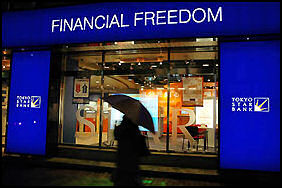
Trade has traditionally been controlled by very large diversified commercial houses known as “sogo shosha”. Many have their roots in the Meiji period. Over the years, big Japanese trading firms have morphed into all-encompassing investment companies with controlling stakes in a whole swath of industries like natural resources, restaurant chains and grocers.
Japan's five great “sogo shoshas” (trading houses) — Mitsubishi Corp (the largest in Japan), Sumitomo, Itochu Corp., Marubeni Corp and Mitsui and Co. — are involved in the trading of stocks, bonds, basic commodities such as metal and grains, and a wide range of financial items, industrial goods and consumer products. Mitsubishi is Japan’s largest trading company. Mitsui is No. 2.
In terms of turnover the five sogo shoshas are the five largest companies in the world, far ahead of its nearest rival, General Motors. They are able to amass such huge turnovers figures because most of their activities involve trading on slim profit margins.
Nikko Cordial was one of the largest Japanese brokerages in terms of revenues. In December 2006, top executives with the frim quit over accounting irregularities. The scandal was a blow to Citigroup which had strong ties with Nikko Cordial. In April 2007, Citigroup paid $7.7 billion to take control of Nikko Cordial by upping its stake from 4.9 percent to 61.1 percent in what was the largest ever acquisition of a Japanese company by a foreign firm. In May 2008. Citigroup’s Japan unit merged with Cordial to create a new holding company named Nikko City Holdings
The trading houses Mitsubishi and Mitsui are involved in a number of energy projects including ones to develop natural gas deposits above the Arctic Circle on the Yamal Peninsula in northwestern Siberia. By some estimates 30 percent of the world’s natural gas reserves lie in the Arctic. BP billed a subsidiary of the trading house Mitsui $1.9 billion to cover the costs of the Gulf of Mexico oil spill.
Nomura Securities
Nomura Securities became the world’s largest independent investment bank after it picked up key Lehman Brothers assets in Asia, the Middle East and Europe at fire sale prices after Lehman collapsed in autumn 2008. Nomura is the first Japanese bank to become significantly involved in the Islamic banking system. In many cases it uses business bases it obtained from Lehman Brothers.
Nomura bought Lehman's international operations in September 2008, swelling its global work force by more than 8,000 in Europe and Asia. In the United States, Lehman's investment banking and capital markets operations, and 10,000 Lehman workers, were swallowed by Barclays, the British bank.
Nomura Securities is the world's largest securities firm and independent investment bank. It has been implicated in scandals involved manipulation of railroads stock, helping gangsters sell stock at inflated prices, obtaining special number accounts for favor clients, and paying $400,000 to compensate losses accrued by the brother of a gangster.
Nomura and Lehman Brothers
In October 2010 the New York Times reported: “The discreet sign by the door does not say Lehman Brothers. But step inside: a bit of Lehman lives on here in Manhattan. Two years after Lehman's collapse, hundreds of former Lehman employees are working together again at the Wall Street headquarters of Nomura, the Japanese brokerage giant. The Lehmanization of this tradition-bound Japanese bank is startling. The head of investment banking came from Lehman. So did the chief risk officer, who held a similar post at Lehman. The top global economist, the co-heads of fixed income, senior salesmen, traders — the list goes on. [Source: Graham Bowley; Susanne Craig and Peter Lattman, New York Times, October 4, 2010]
“The arrivals are part of one of the most aggressive — and potentially most risky — expansions under way on Wall Street. Nomura, a heavyweight in Japan, is a perennial also-ran in the United States. But in the wake of the financial collapse, its executives sense an opening. Rivals scoff at the idea that Nomura can break into the big leagues here. Nomura tried in the 1980s, and again in the 1990s and 2000s.” ''The Japanese banks have always wanted to come here for the prestige,'' said Edward Lincoln, director of the Center for Japan-U.S. Business and Economic Studies at New York University. ''This is the place you have got to be, but they have never made much headway.''
“And yet at a time when giants of American finance have begun to cut back again, Nomura is hiring,” the New York Times reported. “Today it employs 1,900 people inside the World Financial Center in Lower Manhattan and its eight other offices in the United States and Canada. That is up from 650 two years ago. Still, skeptics like Mr. Lincoln see a culture clash coming. They wonder if Nomura will be willing — or able — to offer the big paydays that many American bankers have come to expect.
Naoki Matsuba, the president and chief executive of Nomura's American operations, is confident that this time his bank will succeed. ''This is a once in a lifetime opportunity,'' he said. Mr. Matsuba represents the will of Nomura's ambitious president and chief executive back in Tokyo, Kenichi Watanabe. Mr. Matsuba said that in the wake of the financial collapse, companies and investors would think twice about their bankers.
Lehman was a strong bond house, and many of the former Lehman people at Nomura are on the fixed income side, whereas the new staff on the equities side of the firm come more from all over Wall Street. A former Bank of America executive, Ciaran O'Kelly, a wiry Irishman, is running Nomura's expanded equities operations. David Steck, from Deutsche Bank, heads foreign exchange. Yet of the roughly 1,000 new workers, about 250 arrived from Lehman Brothers. Among them are people like Jeffrey Michaels and Charles Spero, the joint heads of Nomura's fixed income division, where the head count has risen to 360 people, from 60.
Some of the new employees are refugees from the shake-up since the financial crisis and seem glad to still have a job. They acknowledge that taking business from the established Wall Street firms is going to be hard. Others, however, are stars poached from rivals. Nomura is making much of its recent hiring of one of Wall Street's best brokerage analysts, from UBS, as well as a widely respected media industry analyst, from Sanford C. Bernstein. It is also beefing up its investment banking business, run by the former Lehman banker Glenn H. Schiffman. The staff count in investment banking has rocketed to about 100, from 12 at the start of the year. The chatter on Wall Street is that, despite the Japanese reluctance to pay big salaries, scores of new hires are being lured by hefty amounts, including some on generous two-year guaranteed contracts. Nomura executives deny they are paying above the market rate.
In February Nomura raised $3 billion on international debt markets, its first United States public bond sale, to back its push in the United States and globally. In another sign of its ambition, after giving up its license in November 2007, last year it once again became a primary dealer in the Treasury bond market. It still has a long way to go: Nomura ranks 17th in United States-marketed bond underwriting so far this year, compared with 25th in 2009, according to Dealogic. It is even further down the league tables, at 35th, in mergers and acquisition advice. But it is taking some strides forward: its newly assembled fixed income analysts team was ranked seventh for 2010 in a closely watched Institutional Investor survey, the first time Nomura has even been ranked.
Insurance and Real Estate Companies in Japan
Japan has the world's second largest insurance market. The total assets of Japan's five largest insurance companies are estimated to be $1.1 trillion. Millea Holding Inc. is Japan’s largest insurer. It owns Tokio Marine & Nichido Fire Insurance.
Seven insurance companies went bust after the collapse of the economic bubble. During the bubble year they promised high yields of up to 6 percent on their policies and made a lot speculative investments in real estate and stock that went bust. Insurance companies have been hurt by low stock prices.
Nippon Life Insurance Co. (Nissay) is Japan’s largest life insurance company. In fiscal 2011 it had revenues of ¥4.9 trillion, a profit of about ¥ 230 billion and 70,000 employees. With growth opportunities shrinking at home the company is increasingly look abroad for opportunities and has formed a capital and business alliance with German insurer Allianz to meet those ends.
Dai-Ichi Life is Japan’s second largest life insurer. It was expected to make a profit of ¥50 billion in fiscal 2010-2011 but ended making a profit of about ¥19 billion after the earthquake and tsunami in 2011 not because of the disaster but because it is the second largest holder of TEPCO stock.
Mitsubishi Estate is the largest Japanese real estate company. It had a profit of ¥55.8 billion in fiscal 2005-2006
Image Sources: 1) Bank of Japan Cuurency Museum 3) 8) Wikipedia 4) Jun at Goods from Japan 5) Danny Choo , Others japan-photo.de japan-photo.de ;
Text Sources: New York Times, Washington Post, Los Angeles Times, Daily Yomiuri, Times of London, Japan National Tourist Organization (JNTO), National Geographic, The New Yorker, Time, Newsweek, Reuters, AP, Lonely Planet Guides, Compton’s Encyclopedia and various books and other publications.
Last updated October 2012
